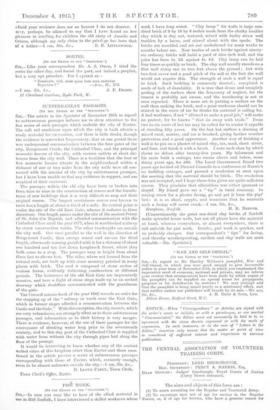SUBTERRANEAN PASSAGES.
[To THE EDITOR OF THE " SPECTATOR.°1 SIR,—The article in the Spectator of November 20th in regard to subterranean passages induces me to draw attention to the fine series of such passages which underlie the city of Exeter. The soft red sandstone upon which the city is built affords a ready material for excavation, and there is little doubt, though the evidence is somewhat fragmentary, that at one period there was underground communication between the four gates of the city, Rougemont Castle, the Cathedral Close, and the principal monastic houses of the city, with various outlets at short dis- tances from the city wall. There is a tradition that the four or five monastic houses situate in the neighbourhood within a distance of one or two miles frcm the city walls were all con- nected with the interior of the city by subterranean passages, but I have been unable to find any evidence in support, and am sceptical of their existence.
The passages within the old city have been so broken into from time to time in the construction of sewers and the founda- tions of new buildings that it is very difficult to map out their original course. The longest continuous course now known to exist has a length of about a third of a mile. Its central point is under the site of the old East Gate, whence it radiates in three directions. One length passes under the site of the ancient Priory of St. John tl e Baptist, and afforded communication with the Cathedral Close until the year 1877, when it was blocked midway by street construction works. The other two lengths are outside the city wall. One runs parallel to the wall in the direction of Rougemont Castle, then sweeps round and cresses the third length, afterwards running parallel with it for a distance of about one hundred and ten feet down Longbrook Street, where they both come to a stop. The passages vary in height from about three feet to eleven feet. The sides, where not formed from the natural rock, are built up with stone masonry patched in many places with brick. The roof is composed of stone arches of various forms, evidently indicating construction at different periods. The buttresses of the old East Gate are impressively massive, and here a flight of stone steps leads up to an arched doorway which doubtless communicated with the guardroom of the gate.
The Council minute-book of the year 1642 records an order for the stopping up of the " subway or vault near the East Gate, which in former sieges afforded a communication between the Castle and the Gate." With this exception, the city records, which are very voluminous, are strangely silent as to these subterranean passages, and information as to their history is very meagre. There is evidence, however, of the use of these passages for the conveyance of drinking water long prior to the seventeenth century, and to this day part of the Cathedral Close is supplied with water from without the city through pipes laid along the floor of the passage.
It would be interesting to know whether any of the ancient walled cities of this kingdom other than Exeter and those men- tioned in the article possess a series of subterranean passages corresponding with those of Exeter, which, curiously enough, seem to be almost unknown outside the city.—I am, Sir, &c.,




















































 Previous page
Previous page